How To Sell On eBay: The Ultimate Guide

eBay selling is a great way to make additional income and can be the foundation for growing a successful business. And it’s not as difficult as you might think!
In this article, we’ll give you a step-by-step guide on how to get started selling on eBay, from creating your account to listing your items and shipping them off to your buyers.
Our guide will equip you with all the tools and information you’ll need to get your eBay store off the ground.
What is eBay?
eBay is an online marketplace that allows people to buy and sell items in a wide variety of categories across the globe. eBay has been in business since 1995 and is one of the most popular eCommerce marketplaces in the world.
eBay also offers sellers a wide variety of services, including auctioning, payment processing, shipping, and customer support.
eBay has billions of listings with just about anything you can imagine buying at your fingertips. The fact that this site is free and open to buyers across the world makes it a reliable and attractive online platform for buying items of almost every kind.
How to sell on eBay: The secrets of a successful business
Figure out how much time, money, and effort you can afford to put in
As with anything in life, building a successful business on eBay doesn’t happen overnight. Many people open eBay stores and put in very little effort and then wonder why they aren’t being flooded with sales. If you are serious about selling on eBay, being successful will require time, effort, and investment.
If you are not willing to invest money into acquiring inventory, marketing, and storage or aren’t ready to put effort into your product photos and listing descriptions, you’re setting yourself up for failure.
You need to see your eBay business as you would any other job. Show up, put in the work and you will reap the rewards.
An example of someone who got their start on eBay is Sophia Amoruso. You may now know her as the woman behind the Girl Boss empire, but her fashion business had humble beginnings in her bedroom back in 2006.
She sold vintage clothing under the store name Nasty Gal, trying to scrape together enough money to cover her rent. What set her apart from the thousands of other stores selling vintage clothing on eBay?
She put in a lot of time taking great photographs of the clothing, writing detailed listing descriptions, and shipping items to buyers quickly.
It didn’t take long for Nasty Gal to gain a good reputation for being the place to buy vintage brand-name clothing. Within 6 years, Nasty Gal grew to be a fast-growing fashion retailer turning over almost $100 million in revenue.
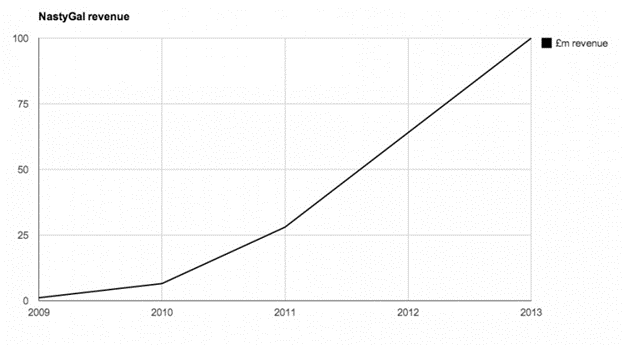
While Sophia turning her eBay store into a million-dollar business is a rare anomaly, that’s not to say you can’t be successful too. Many businesses today had their roots selling on eBay.
Decide on your niche
Option 1: Sell what you already own
Total beginners do best when reselling items that they already own. For example, perhaps you have a large collection of old records that you no longer use. Instead of leaving them to gather dust in your attic, you can sell them on eBay.
Antiques, collectibles, and vintage items fetch higher prices on eBay but regardless expect to sell items for less than you paid for them. Items will rarely fetch higher prices than their retail value.
If an item is in high demand and you auction it off, however, you never know what price you might end up selling it for.
It is also worth noting that you’re more likely to succeed on eBay if you sell items you are actually interested in. If you sell bike parts but are into fashion, you’re unlikely to remain invested and engaged in your online business, which will show, leading to fewer sales.
Option 2: Sell what is trending
When you start your eBay store, you are limited to only selling 10 items with a total value of $500 to help you get the lay of the land. So, you’ve got to make sure you’re listing items that are going to sell. You can use an automation tool to look for hot products to give you a head start.
You can use eBay’s homepage for product ideas, but you may struggle to find information about the most profitable products. eBay Watch Count is a purpose-built tool that will show you the most watched or hottest products of the day to help guide your decisions.
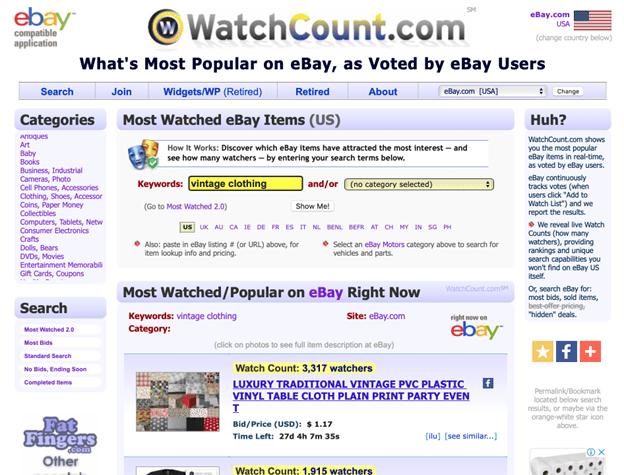
You could use a tool like ZIK Analytics to find profitable, trending products with data about the amount of competition, the number of products sold, and average prices.
If you want a free research tool, another alternative is to use Google Trends. It displays a graph showing you how a niche has been trending based on Google Searches.
Top tip: Use the search terms in your product descriptions for an SEO boost!
By figuring out what you can sell easily, and at what prices, you will have an edge over competitors. Your store will grow quickly if you sell in-demand products.
Additional reading: How To See Sold Items On eBay: A Step-By-Step Guide.
Set up a dedicated workspace
It is important to have a space designated for your eBay business. Setting up a designated workspace can:
- prevent your inventory from being damaged or losing products
- help you keep track and manage inventory
- improve your productivity
- streamline your packing and shipping process
When you’re starting out, there’s no need to rent an office or storage unit. You can set up your workspace in a bedroom, your garage, or anywhere you’ve got some extra space. As your business grows, you may find you need an extra storage unit, unless you’re dropshipping products to customers.
Choose a business model
There are many ways to sell on eBay, so your business model depends on the product you’re selling, your location, and several other factors. Let’s look at the various business models you can use to run your eBay business.
1. Dropshipping
Dropshipping is an excellent business model for resellers looking to keep inventory and overhead costs low. You can purchase items from your supplier and ship them directly to your customers from the supplier.
This way you avoid any storage costs and don’t double-up on shipping costs (i.e., shipping from supplier to you and from you to customer).
Keep in mind that eBay has a dropshipping policy that prohibits anyone from dropshipping from other marketplaces or retailers.
2. Selling used items
You can find profitable items to sell by going through your cupboards, garage, attic, or basement and getting rid of items you no longer use or need. This can include anything from electronics, toys, bags, vases, collectibles, books, etc.
It is best to sell lightly used items that are still in good condition. If an item is slightly damaged, however, it is best practice to note this in your listing description.
This mitigates the risk of the buyer being surprised by any faults and leaving an unfavorable review – bad reviews when starting out will reduce buyer trust in your shop and impact eBay sales.
3. Retail arbitrage
Retail arbitrage is a strategy employed to make a profit by purchasing inventory at lower retail prices and reselling products at higher prices.
4. Private-label/white-label products
Selling private label or white label products means that you purchase products to sell from a manufacturer and rebrand the generic product with your own branding.
For example, let’s say you want to sell essential oils on eBay. You can purchase from a manufacturer and then have them put your label on the products to resell on your eBay store.
White label products can be highly profitable but do require an upfront investment. Your private label product can stand out from the competition so if you have the capital to outlay, this can be a great business model.
5. Wholesale
If you are willing to buy in bulk and stock up on items, then offer them at discounted rates for resale, consider a wholesale business model.
You can purchase products directly from a supplier or through a wholesale marketplace like DHgate or Alibaba. This business model will require you to have adequate storage space to safely store your inventory.
For example, if you want to sell coffee beans on eBay, you can purchase coffee beans at wholesale prices and then package them in smaller batches and resell them for a profit.
How to sell on eBay step-by-step for beginners
Alright, now that you’ve decided on what to sell, you’ve got your workspace set up and you’ve chosen a business model that works for you, it’s time to set up your eBay account.
Step 1: Create a new eBay sellers account
The great thing about eBay is that absolutely anyone can sign up for an account. The process of setting up a new seller account is very simple and user-friendly. To sign up for an eBay seller account, follow these steps:
- Navigate to the eBay sign-up page.
- Input your name, email, and password. You can also log in using Facebook, Google, or Apple.
- If you want to create a business account, there’s a separate link you should click on that reads, ‘create a business account.’ It will redirect you to a form where you can input your business details.
- After creating your account, eBay will log you in and assign you a username that you can change in your account settings. Ensure whatever name you choose will be easy for customers to find you again should they want to purchase again. Avoid long, complicated names with odd spelling or symbols.
Once your account has been created, you will be taken to the Seller Hub. This is a dashboard where you can manage and complete your transactions, track payments, complete transactions, and more.
Step 2: Set up your payment method
You need to add a method by which you can receive payment for your sales. You can choose the frequency with which you will be paid. To do this follow these easy steps:
- Navigate to “My eBay.” Under the Accounts tab, click on Payments. Select Payment Options.
- You can choose to enter your payment information and have eBay credits automatically go to your bank account according to your preferred schedule. Alternatively, you can receive payments through PayPal or both.
- Before your eBay account can start generating income, you need to have managed payments active to pay for insertion and final value fees. Those eBay seller fees are deducted before payments are made to your bank account or PayPal account.
Step 3: Take professional photographs of your eBay listings
To make your product look appealing, it is important to take high-quality photos, with an actual product as opposed to a drawing or 3D model.
Details such as the size of the product and colors need to be highlighted in each photo. It can also be helpful to take photographs from several different angles.
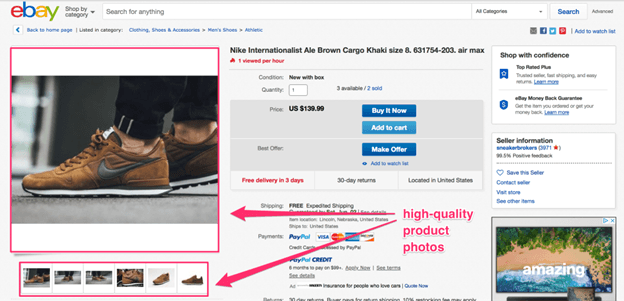
Pay attention to lighting and use a high-quality background. Products against a plain white background tend to do quite well. Buyers also like to see the product in use to get a sense of how it works.
Step 4: Add your first eBay listing
Navigate to the “selling” overview page. Click the “list an item” button to add your first listing.

The two ways to list an item on eBay are as a fixed or automated “Buy It Now” listing or an auction. Buy It Now or fixed price listings bypass auctions and allow buyers to purchase the product immediately without having to wait to see if their bid wins.
Auctions
Listings can be sold at higher prices when auctioned off. You can set a reserve price to ensure that no product sells for lower than what you want for it.
If you want to guarantee a sale, using auctions can be an excellent way to do so. Many sellers find that their products fetch higher prices when listed as an auction item as opposed to “buy it now.” To determine which listing type will yield the most sales for your product, watch what other sellers in your niche are doing.
As a rule of thumb, auctions work best for collectibles, antiques, and vintage items where quantity is limited and demand is high.
Buy It Now
Buy It Now listings are more suitable if you will be selling wholesale products, general second hand products, or private label products.
You should consider your selling limits when adding listings to your eBay store. Sellers are limited to selling 10 items per account per month with a total value of no more than $500 when starting out.
This isn’t a problem for someone with only a few products to list (e.g., when you’re getting rid of unwanted household goods), but it can be an issue for those who want to open a store on eBay as a business.
eBay will upgrade your limits as time goes on based on your sales history, customer feedback, etc. You can also talk to eBay customer service to upgrade your account once every month.
Write great listing descriptions
When you list a product on eBay, it is crucial to provide detailed information about the product in the listing description. As we mentioned, you should always use images you have taken of the product as opposed to stock photos.
Your description should include relevant information like product attributes (colors, size, etc.), variations, and unique identifiers.
It is also worthwhile paying attention to the listing title as this will be the first thing that catches buyers’ attention. Your title also influences where your products show when a relevant search query is run.
On the topic of searches, use the search terms or keywords you found when you were searching for profitable products in your listing descriptions. This will increase the odds of your listings being found when shoppers are searching for similar products.
eBay customers want as much information about a product as possible to ensure they’re getting exactly what they’re looking for. Effective, information-rich eBay listings help reduce returns and eBay negative feedback because they provide accurate information about the product.
This helps the buyer avoid nasty surprises like an item arriving much smaller than anticipated or a different color, for example. The below description has all the information a prospective buyer would need to make a purchase decision.
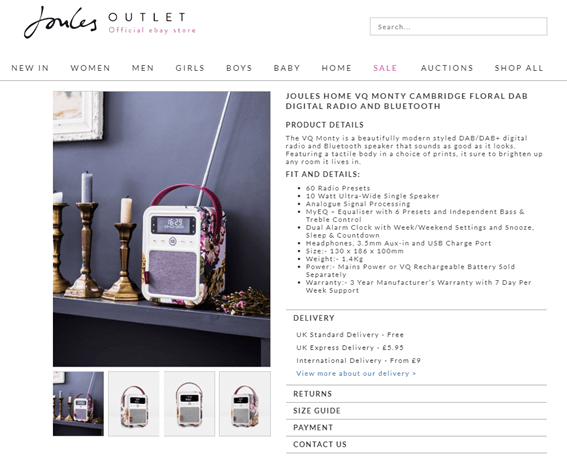
If you need to get started in a hurry, you can use the Quick Listing Tool. It will help you start out by organizing and presenting lots of relevant details about your product in seconds based on similar items. However, we recommend doing this manually when starting out.
eBay offers sellers so many listing fields that can help add important information to each listing, so they rank better in searches. Some examples include special attributes, genre, lining material, age level, style, and other fields people might use to filter searches.
Step 5: Create your return policy
It is vital to set clear expectations for customers. Your store’s return policy can impact how much you sell, your bottom line, and customer satisfaction. eBay has a Money Back Guarantee policy that protects buyers from dodgy sellers.
The policy requires sellers to issue refunds in the case of lost packages, damaged goods, or goods that do not match the listing images and description. So essentially, by signing up to be a seller on eBay, your shop is automatically assigned a return policy.
Agreeing to add eBay’s 60-Day Buyer-Paid Returns Policy to your store can give your listings search visibility a boost. It is advisable to include a clause that buyers are required to return items unused and in their original packaging. Learn more about setting up your return policy through eBay’s return policy documentation.
Step 6: Set up your shipping
Before you start selling on eBay, you should figure out how you are going to ship your items. Shop around for a reliable and cost-effective courier service before setting up your eBay store.
If you fail to do this before opening the shop and getting an order, nothing will annoy a buyer more than shipping delays or unforeseen shipping costs.
Consumers prefer fast shipping to economy shipping. When you offer both, you’ll find that a majority of buyers will select the faster delivery option if it’s available to them.
People who shop online want the product as soon as possible, so the faster you ship, the more likely you are to receive favorable reviews and repeat business.
Get your shipping costs upfront from your service provider so you don’t come up short. Undercharging for delivery will impact your profit margin.
Once you receive payment confirmation for an order, go to “My eBay” and print a shipping label. You have various shipping options depending on the type of store you have.
Domestic or international shipping is an option depending on where your store is located. Popular choices in the United States are USPS, UPS, and FedEx.
Step 7: Make sure your eBay store develops a good reputation
When you open a new eBay store you start with no feedback. A prospective buyer has no way of knowing whether you’re legit or if you are a trustworthy seller.
So, it is important to try and generate positive feedback as soon as possible. Shops with great reviews instill confidence in buyers and are more likely to make sales.
To help you get more sales and positive feedback, here are a few tips:
- Make sure to post optimized listings with clear product descriptions and professional images.
- Offer free shipping if possible.
- Take high-quality pictures to help customers understand what you are selling and what they can expect to receive.
- Follow up with a thank-you note once the order has been delivered and request feedback on their experience.
- Don’t try cut costs by using a different shipping method than the one the customer has paid for.
- Package items nicely and securely, especially if products are fragile.
When requesting feedback from a buyer, be polite and to the point. Here is an example of a review request:
Hello {name},
Thanks again for your order! I wanted to make sure you received the item in good condition and that it met your expectations. It would make my day if you could take a moment to leave feedback on your experience on my shop’s page.
I hope you’ll be back for more {your product} soon again.
Until then, cheers,
{your name}
Here is another example of a follow-up message to your customer:
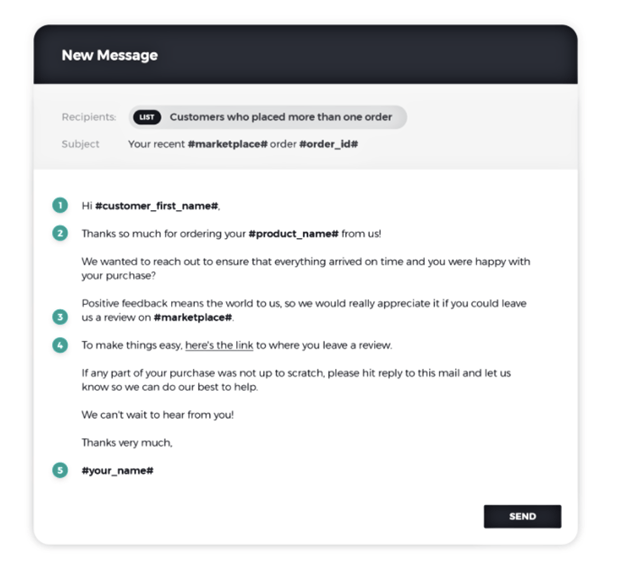
To summarize this section, creating a listing is one of the most important parts of selling on eBay. Your listing is what will sell your item, so it’s important to make it as eye-catching and informative as possible by doing the following:
- Use high-quality photos that show your item in its best light at multiple angles.
- Write a clear and concise description that highlights all the features and benefits of your item.
- Choose the right category and subcategory for your item.
- Set a realistic price that reflects the value of your item.
- Choose the right shipping option for your item (e.g., USPS First Class, UPS Ground, etc.)
That pretty much wraps up how to sell on eBay for a beginner. As you can gather, it’s quite straightforward. The key to setting yourself up for success boils down to the effort you’re willing to put in.
If you haven’t quite figured out what to sell on eBay yet, let’s look at some of the most profitable niches on eBay to help you narrow down your offerings.
10 best-selling items on eBay in 2025
As we’ve gathered, eBay is one of the world’s largest online marketplaces, with millions of buyers looking for everything from clothes and electronics to home goods and collectibles. Here is a table with the top categories and average prices as a guide.
Before you start listing products, it’s helpful to know which categories are most popular with buyers. That way, you can choose items that are likely to sell quickly and for a good price.
1. Mobile phones & accessories
With global demand for cellphones on an upward trend, it’s no wonder that used mobile phones and phone accessories are in high demand on eBay. Apple and Samsung are the most popular brands while best-selling accessories include phone covers and cases, in-car phone holders, and earphones.
When selling used mobile phones, be sure to use unedited pictures that clearly show any flaws such as cracks or scratches. Honesty is the best policy on eBay.
2. Video games
Vintage and second-hand games are hot commodities on eBay. Gaming has boomed in the last few years and is set to continue to do so, so if you have a collection of old video games in working order or can source games in high demand, you’re looking at a lucrative business opportunity.
In a time where many find themselves nostalgic, games dating back to the 80s and 90s are in high demand.
3. Health & beauty
Own a skincare brand or buy beauty products wholesale? This is a popular niche on eBay. Fragrances, skincare, haircare, and make-up products are very popular, especially if you own some discontinued products that people are desperate for.
If you sell discontinued products, always include the expiration date and be transparent about how old the product is. You should also always list the product ingredients where possible in case a buyer is allergic to something in the products.
4. Home & garden
eBay is the go-to platform for many buyers looking for vintage home and garden products, used items, or new items from recognized sellers. Tools are a big seller with the best-selling brand being DeWalt.
For the home, water filters, kitchen storage & organization products, and bar products are very popular items on eBay. When selling vintage items or antiques, include the year of creation, item condition, and any special story behind the item that may tug on the heartstrings of potential buyers.
Remember, appealing to buyer emotions is a tried-and-true sales technique.
5. Computers and tablets
Used and new computers, tablets, and Kindles are very popular on eBay. Printers, scanners, and copiers also sell well. So, if you buy and sell used computers and computer accessories, taking your shop to eBay is a smart business move.
When buying second-hand, buyers want the lowest prices so monitor your competitors’ pricing, so you don’t over-price your goods. Again, if a used item has a flaw, be transparent about it in your photos and descriptions.
6. Instruments
If you have a collection of musical instruments that you no longer use, you can generate good income by selling them on eBay. Vintage musical instruments are also very popular amongst eBay buyers. Microphones, guitars, and bass guitars are the best-selling items in this category.
7. Camera equipment
Most people enjoy taking photographs to capture memories so at some point they will investigate buying a new or used camera. Digital cameras, drones, and vlogging equipment are the top sellers in this category, especially as more and more people try to make it on YouTube and TikTok.
Camera descriptions require a lot of technical information, so make sure you include relevant details to improve the chances of a sale.
8. Clothing, shoes, and accessories
Who doesn’t enjoy clothes and shoes? And everybody needs them, so this is always a good niche to dip into, albeit a saturated one.
The most popular new clothing items on eBay are printed graphic t-shirts, especially where the prints are retro and hard to find in retail stores.
Vintage clothing is the most popular niche in this category with buyers coming to eBay in search of a specific item or brand. Used branded clothing from the likes of Zara, Chanel, and sports brands sell well.
When selling vintage items describe the year of creation, era, and any relevant attributes.
9. Jewelry and watches
Buyers come to eBay in search of used jewelry and watches. For example, someone may be in the market for a used Rolex watch and look on eBay if a watch that meets their requirements is available. Vintage jewelry and watches, especially diamond jewelry, are also top-selling items.
Some people prefer a vintage engagement ring, for example, rather than a new one bought in a store, especially if there is a romantic story behind the ring.
10. Toys
Parents are willing to drop serious money when it comes to buying things for their kids. Educational toys like puzzles and Legos sell well.
Vintage toys are also in high demand such as specific action figures, dolls, stuffed toys, and vintage train sets. Disney, Marvel, and Hot Wheels are also sub-categories that are some of the most searched-for items.
Remember eBay does tend to be a marketplace for used goods people can pick up at a deal rather than new items. But that’s not to say private label shops or wholesalers don’t succeed on eBay. If you market your items the right way, you can succeed no matter what you sell.
Interested in finding out what the top selling items are for Etsy? Then check out these 41 profitable Etsy shop ideas to get you started!
Consider cross listing your products to other marketplaces
Now that you have mastered how to sell on eBay, you should consider listing your products in other marketplaces. The more marketplaces your products appear on, the more sales you’re likely to make.
Not everyone will go to eBay when they are searching for the types of items that you’re selling. For example, if you sell vintage clothing, you should also list it on Poshmark, Mercari, and Depop.
Sounds great, but you’re probably already rolling your eyes at how long that’s going to take you. Listing on more than one marketplace is time-consuming.
But it doesn’t have to be! You can use our tool, Crosslist, to cross list your listings to multiple marketplaces within minutes! Crosslist takes the frustration, time, and hassle out of manually uploading your listings to other online marketplaces by exporting your listings in bulk to your chosen marketplaces.
It’s as easy as this:
- Bulk import your eBay listings to Crosslist
- Select the listings you want to cross list
- Click the Cross list products button
- Choose the marketplace you want to cross list to and hit Publish
- In seconds, Crosslist will automatically post your listings to the relevant marketplaces
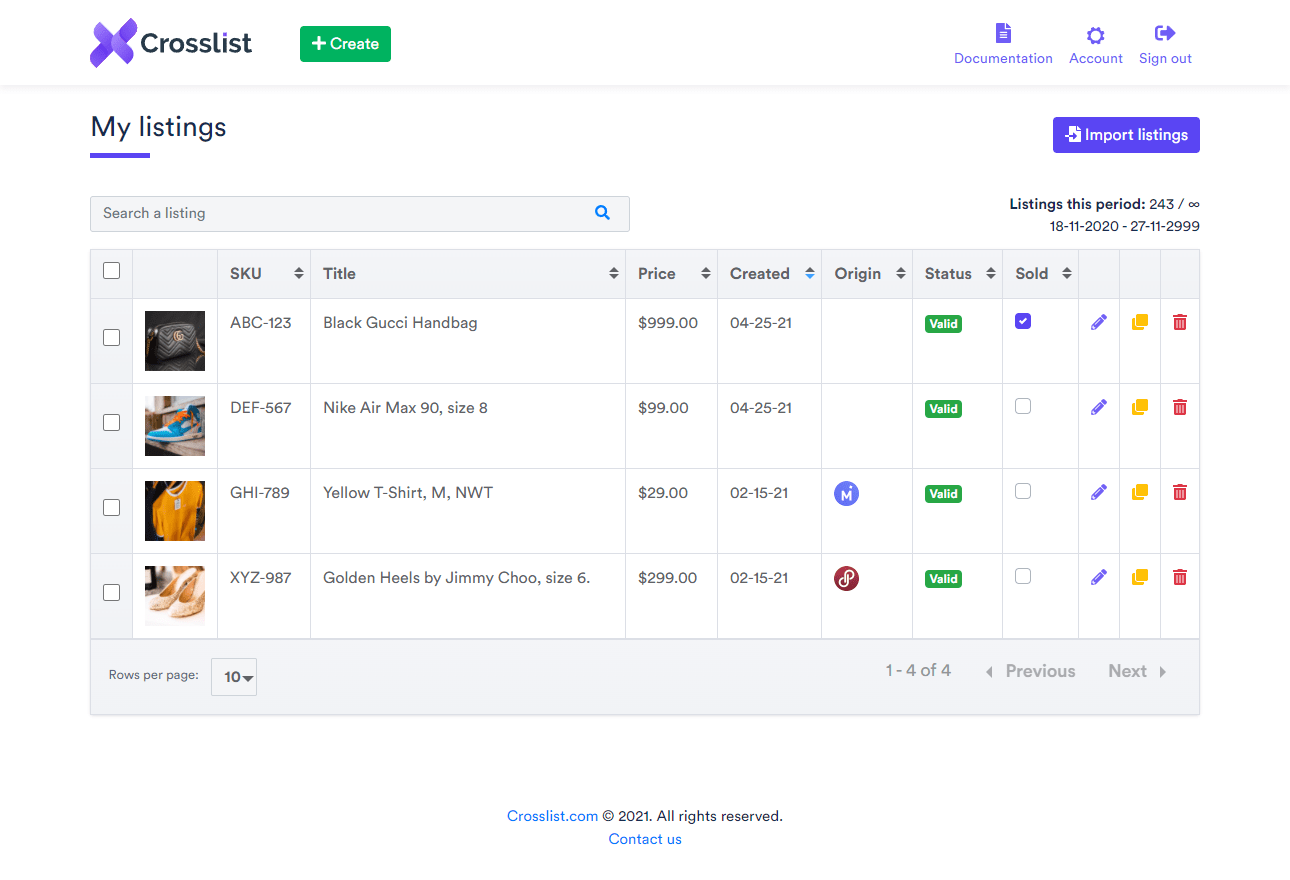
Check out our website to learn more about how Crosslist works and which marketplaces are supported.
Curious about how Crosslist stacks up to other cross listing tools? You can check out a side-by-side comparison here.
Final thoughts
There has never been a better time to start selling on eBay. Equipped with all the knowledge, tips, and tricks of how to sell on eBay, you are ready to start your online business and earn an income.
Turning your eBay shop into a success doesn’t require any fancy tricks or tools. What you put into your store is what you will get out.
Questions or just say hello!
Well, congratulations to you for making it this far! Here’s a reward in the form of a 10% discount code on your first month of Crosslist (add during check-out). Sign up now with a 3-day money-back guarantee!
10% off
BLOG10
You can learn more about how Crosslist works here.
If you have further questions, feedback, bug reports, or want to know a bit more about us, why not swing by for a chat and say G’day! You can have a chat with us through Messenger.
